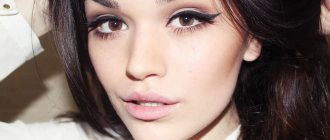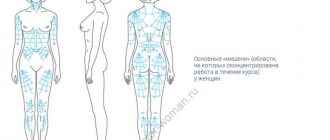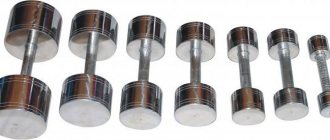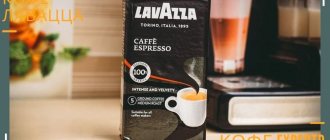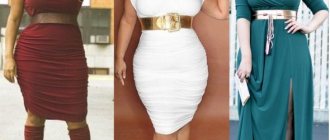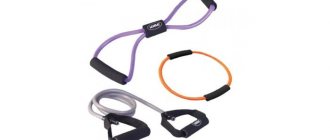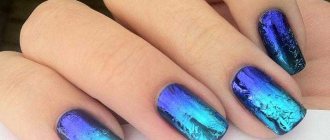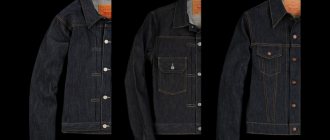Ear piercing has always been popular among both men and women. This is evidenced by numerous archaeological finds in different parts of the world. In our review, we will discuss in detail the topic of ear piercings, types and proper care for them.
Stylish ear piercing: types and complexity of punctures
Ear piercings are considered the most popular and common in the piercing world. All this is thanks to the large selection of puncture zones and the presence of large space for inserting several jewelry at once. We invite you to get acquainted with each type of ear piercing in more detail.
Ear piercing jewelry
Nowadays ear piercing jewelry can be chosen to suit every taste and color. They are made from different materials - silver, gold or medical steel, but they are not suitable for piercing due to the presence of nickel in the alloy, which oxidizes when worn; the highest quality and safest jewelry is made of titanium . It is the choice of material that determines how long an ear piercing will take to heal.
Stud earrings and studs have faded into the background; the most popular piercing jewelry has become labrets with wraps, microbananas, barbells, clickers or circulars , the size of which is selected individually for each person. Often, ear piercings on top are decorated with clusters, which are arranged in the shape of the ear, and piercings inside the ear are decorated with clickers with cubic zirconia or opals.
Earlobe piercing
One of the most common types, which is easy to perform and the safest. An earlobe piercing is done using a gun or needle. Due to the absence of cartilage and important points in this area, a piercing on the earlobe heals quickly and rarely rejects the jewelry material.
The puncture of the lobe is most often done without pain relief, since this is the area with the least sensitivity. Even a small child can withstand a second unpleasant sensation, which is why ear piercing is recommended for children aged 3 to 5 years.
Ear Piercing Tunnel
Tunnel piercing has a lot of fans, largely due to its extravagant and provocative appearance. A tunnel is a type of ear piercing in which a special expander, rather than jewelry, is inserted into the hole immediately after the piercing.
The procedure is quite painful, because you will have to wait until the puncture reaches the appropriate size for the jewelry. For the final result you will need at least a month of painstaking work. Sometimes, to avoid a long procedure, an incision is made at the site of the proposed tunnel, which is gradually stretched. Experts do not recommend resorting to such a radical method, as it is more painful and dangerous.
Helix ear piercing
The helix is the upper part of the helix of the ear. A puncture in this place involves impact on the cartilage, which is quite painful. The location of the jewelry in the upper curl of the auricle does not restrict movement and does not interfere with its owner. There are no nerve endings in the cartilage, so the Helix puncture is easily tolerated and heals.
Professional masters claim that the correct Helix puncture is almost painless. If you still experience severe pain during a puncture, then it is better to contact another specialist. When piercing Helix, there is a nuance: you need to select jewelry for the piercing in advance, since the hole in the cartilage does not stretch like on the earlobe. It is important to choose the same puncture size and jewelry diameter.
Piercing at the top of the ear
Follows after the classic one. Divided into 2 types of puncture:
- Helix - cartilage in the curl of the shell. It is not performed with a gun, it is absolutely not sensitive due to the lack of nerve endings in the cartilage tissue. The jewelry is selected before piercing because its diameter cannot be changed later due to the fact that the holes in the cartilage do not stretch.
- Forward Helix - antihelix of the auricle. If there is space, it is possible to make several piercings for different jewelry to be worn at the same time. The procedure, performed only with a needle, does not cause pain at all.
Industrial
Extreme type with double puncture at the upper edge of the cartilage. The holes are connected by a so-called rod. Occurs in men and women. The session is performed without a gun due to fear of infection.
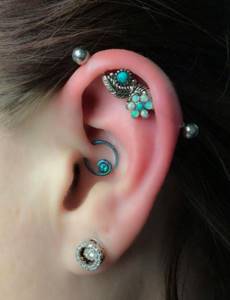
Tragus
Not available to all clients due to the different anatomical structure of the auricle. Requires enormous professionalism of the master to prevent unwanted consequences.
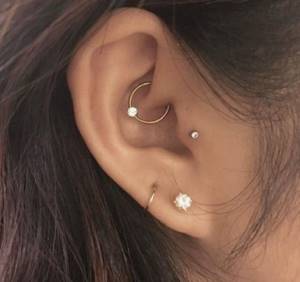
Antitragus
On the contrary, the tragus is slightly higher than the earlobe. The operation is considered easy because it is performed in a convenient area. Not accessible to everyone due to lack of space.
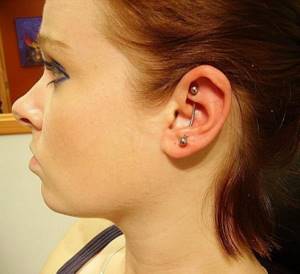
Days
In the outer ear above the entrance to the auditory canal. The puncture is performed vertically. Earrings are selected in the form of a circular ring or clinker. Almost never used in Russia. The disadvantage is the inability to listen to music through headphones.
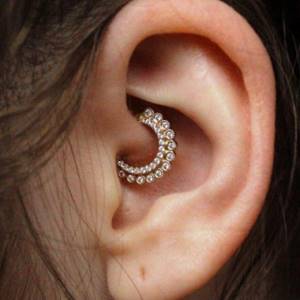
Snug
In other words, the antihelix is in the vertical direction of the middle of the antihelix cartilage. It is done under local anesthesia due to pain.
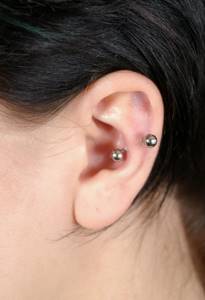
Conch
It is pierced inside the ear near the auditory opening. Manipulation is dangerous due to the risk of damage to blood vessels and nerves. A symmetrical ending is known on both ears. Suggests a labreta or voluminous hoop.
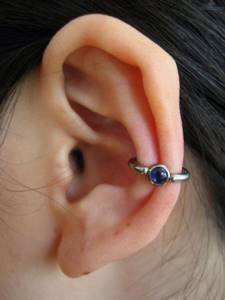
Arm or rook piercing
Angled piercing in the crease at the top of the ear. Hoop earrings look harmonious. It heals up to six months. Most suitable for men, it requires careful care after surgery.
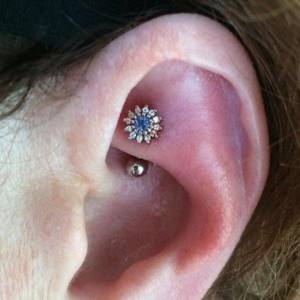
Orbital
Attractive piercing with two piercings between the lobe and helix. They are connected by an earring - a horseshoe or a twister.
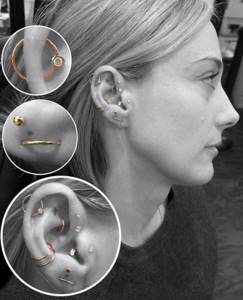
Tunnels
Refers to the earliest method, similar to the classical one. Stretching takes years, the lobe stretches up to 3 mm per month. When scalping, an incision is made to the desired tunnel size.
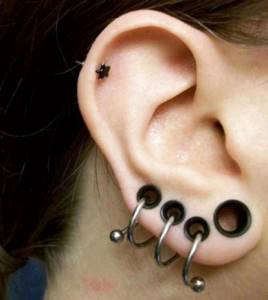
Ear piercing Forward Helix
Another type of cartilage puncture, in which a hole is made on the antihelix. You can make several piercings on the auricle at once and wear 2 or more jewelry. The Forward Helisk puncture is done using a needle. For a Forward Helix puncture to completely heal, it takes about 4 months.
Helix
The puncture is located in the upper cartilage under the helix of the ear. At the moment, the most popular piercing, because in this place you can make several piercings at once, or put a cluster with cubic zirconia or opals, which will emphasize the shape of your ear and also attract attention to its owner. Helix requires careful handling during healing, as well as mandatory replacement of the primary jewelry to avoid distortion of the puncture.
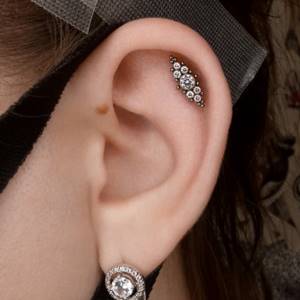
Industrial ear piercing
Industrial piercing is a puncture of the upper cartilage of the ear, in which the holes are connected by a barbell. In the classic presentation, Industrial is a hole on the front of the ear and on the opposite side. Industrial looks great on both men and girls.
A puncture of two cartilages at once takes much longer to heal than one. In the first days after the procedure, it is not recommended to even touch the piercing so as not to injure the ear. Wearing hats and headphones is also prohibited.
Experienced specialists recommend wearing bioplastic jewelry in the first months after the piercing. After the holes have completely healed, you can change it to another material: medical steel, titanium or gold.
Tragus ear piercing
The Tragus or Tragus piercing is a feminine type of piercing on the front of the ear. The tragus is cartilage tissue, so healing and pain will be equivalent to a Helix piercing.
You should not sleep on your ear with a Tragus piercing for several months, nor should you wear headphones or tight hats. Ordinary rings and studs with stones are used as jewelry for Tragus piercing.
Beautiful ear piercing ideas
The classic pierced lobe has been in demand for a long time, despite the variability of fashion, it does not lose its popularity and is not limited to the gender aspect. Modern girls are not content with traditions, turning to interesting options for cartilage piercing. The holes strike at several points, creating multifaceted compositions of different styles. Ideas for fashionable combinations are dictated by celebrities and the first beauties of Hollywood, surprising with rather bold combinations of metal piercings and magnificent jewelry.
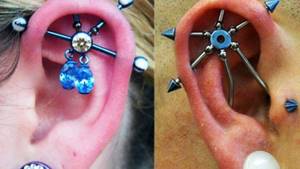
What incredible ear piercing motifs have become trendy:
- on girls, a complex cartilage Tragus with the insertion of stud earrings in tandem with a large stud in the lobe, shining with the mysterious color of the stone, looks impressive;
- a simple Helix successfully combines with two earlobe piercings, the combinations of trendy earrings - cuffs, labrets, rings - do not contradict each other, and the barbell enhances the effect of the double Helix;
- The juxtaposition of the simple Days with the rather sickly Tragus looks quite bold, attracting attention with the modesty of shiny rings, the playfulness of hearts, and the brightness of traditional carnations;
- Particularly striking is the multiple ear piercing - double Industrial, pierced with a long arrow, in combination with Dace, Tragus or Heilix, ending with several piercings of the lobe.
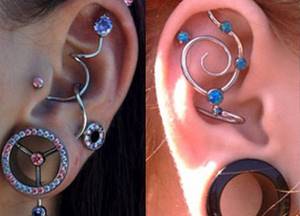
The modern ear piercing industry offers a wide range of earrings made of different alloys, including for pierced cartilage. Beautiful products of various designs and shapes placed in the ear will satisfy any level of aesthetic preferences, delighting girls who want to modify their appearance in an unusual way. After all, decorating earlobes with earrings has already become a long-standing tradition, and perforation of the ear cartilage is rapidly gaining momentum in popularity.
Ear piercing: contraindications to the procedure
First, remember that ear and other body piercings should only be done in a licensed medical facility. Find an experienced specialist whose instruments are sterile. A professional technician will refuse to pierce you if:
- you suffer from blood diseases
- you have had a traumatic brain injury
- suffer from diabetes
- at the time of the procedure are sick with ARVI
- you are underage
- You are pregnant
- have allergic reactions to medications
Sequence of ear piercing procedure
Every professional should follow a standard protocol when performing a piercing procedure. It includes:
- choosing a suitable decoration, assessing its weight and diameter
- treating the future puncture site with an antiseptic or other disinfectant solution
- Using sterile instruments that are taken from a special sterilizer, the master makes a puncture with a needle in a pre-marked place
- immediately after the puncture, an earring or dilator is inserted into the hole
- If bleeding occurs, the master must take all measures to stop it and remove any remaining blood. To do this, the puncture is re-treated with an antiseptic and, if necessary, fixed with a bandage.
How to care for an ear piercing
In the first days after a puncture, a piercing is the most common wound on the body, which the body tries to heal by all means. In order for the piercing to heal safely and you can enjoy the attractive appearance of the jewelry in your ear, you need to adhere to important rules:
- During the healing period of the piercing, touch the piercing only with thoroughly washed hands
- try not to touch the jewelry at all, especially moving it. This can damage the wound and take much longer to heal.
- It is not recommended to visit the bathhouse and sauna, since a humid environment promotes the growth of bacteria
- try to collect your hair in a ponytail or secure it with hairpins. Accidental hair coming into contact with jewelry can cause injury and bleeding.
- If there is an inflammatory process in the wound, treat it daily with an antiseptic and regenerating cream. If the suppuration does not go away for several days, it is recommended to consult a doctor.
Ear piercing is the most popular type of personal body decoration, which lasts for quite a long time and, when completely healed, does not cause any special problems for its owner. If you decide to have an ear piercing, be sure to consult your doctor and choose a trusted professional.
How to care for ear piercings?
After the manipulation, a good master always gives the client recommendations regarding caring for the puncture site. They help prevent infection of the wound and promote its healing process. The most important tips include:
- washing the fresh hole until it is completely healed twice a day (morning and evening) with an antiseptic solution, in this case miramistin and chlorhexidine, which can be purchased without any problems at any pharmacy, work well;
- apply the solution to a cotton swab, and only then clean the wound surfaces;
- It is forbidden to tear off the crusts at the puncture site; if necessary, they should be soaked with antiseptic solutions;
- The decoration must not be pulled or turned in the hole before it is tightened.
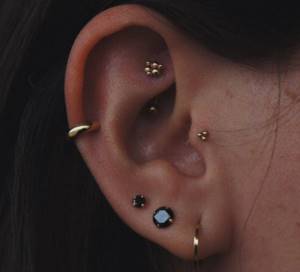
If you carefully care for the wound and follow all the advice of a specialist, the recovery process will not last long and proceeds without complications.
If any abnormalities occur at the puncture site, you should immediately seek advice from a specialist.
